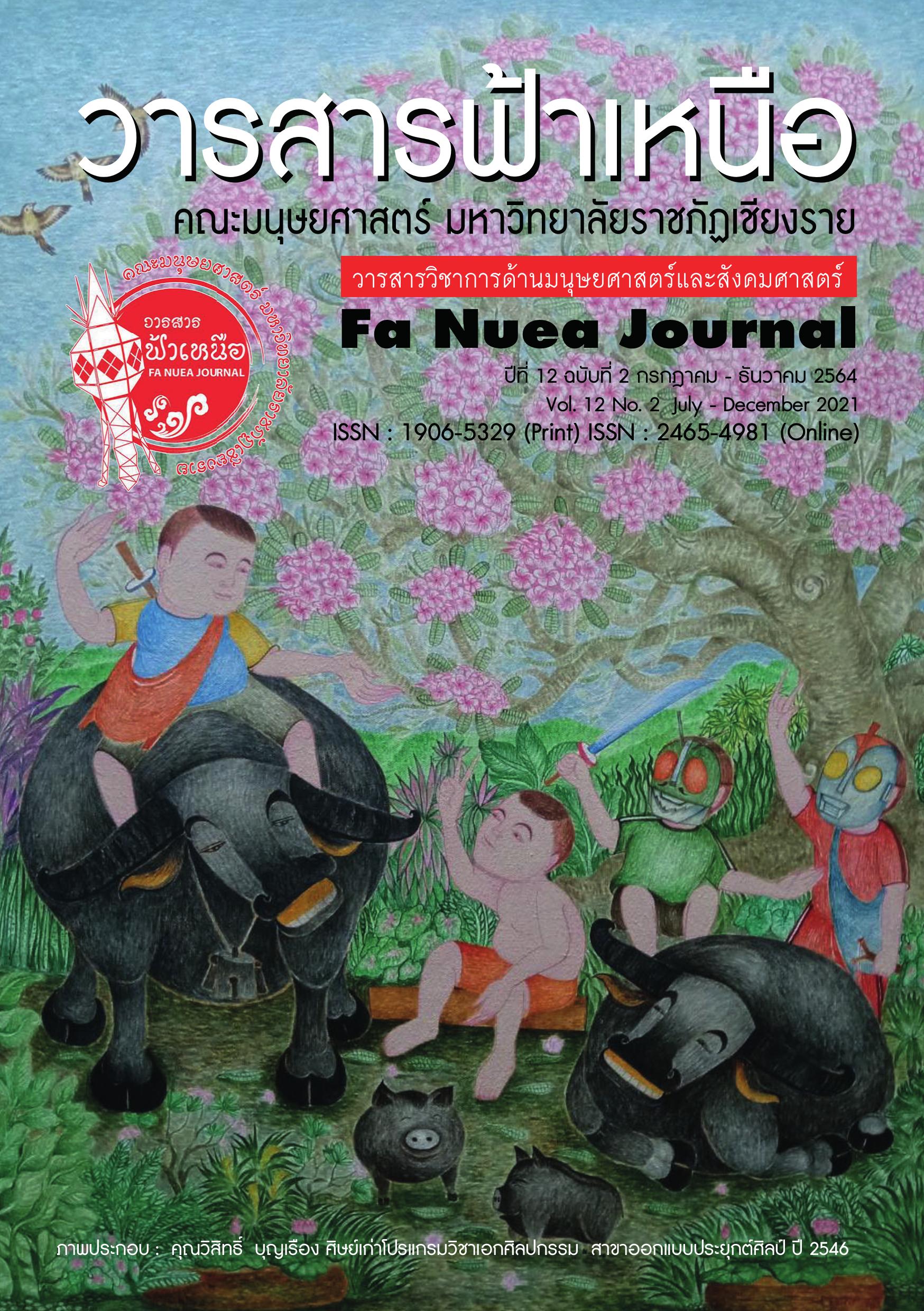The Factors that Affect in Using Mandarin Chinese Based on the 21st Century Learning Skills of the Fourth-year Students from the Bachelor of Arts Program in Chinese Language, Chiang Rai Rajabhat University
Main Article Content
Abstract
The purposes of this study were to investigate the factors that affectstudents’ using Mandarin Chinese according to the 21st century learningskills; and to explore the levels of students’ in using Mandarin Chineseaccording to the 21st century learning skills. The research populations were118 fourth-year students from the Bachelor of Arts Program in ChineseLanguage at Chiang Rai Rajabhat University. Data were collected by a setof questionnaires. The descriptive statistics were used to analyze the datafor frequency, percentage, mean ( ) and standard deviation (S.D.).
1. The overall factors that affect students’ in using Mandarin Chinese were at the high level ( =3.68, S.D. = 0.81). When considereach factor, it was found that the most factors that affect students’ inusing Mandarin Chinese were the teachers, educational institute, andlearners respectively.
2. the levels of students’ in using Mandarin Chinese according tothe 21st century learning skills using the Mandarin Chinese were at themoderate level ( = 3.39, S.D. = 0.57). When consider their aspect in usingMandarin Chinese, it was found that the high level of students’ in using Mandarin Chinese were ranged from communication, creativity and readingrespectively.
Article Details

This work is licensed under a Creative Commons Attribution-NonCommercial-NoDerivatives 4.0 International License.
Articles, information, content, pictures, etc. which have been published in Fa Nuea Journal, are copyright of Fa Nuea Journal. If any person or party wishes to disseminate all or part of it or take any action must be referenced. Do not use for commercial purposes and do not modify (CC-BY-NC-ND). For further details, please access at Attribution-NonCommercial-NoDerivatives 4.0 International (CC BY-NC-ND 4.0)
References
กรมวิชาการ. (2544). หลักสูตรการศึกษาขั้นพื้นฐาน พุทธศักราช 2544 (พิมพ์ครั้งที่ 3).กระทรวงศึกษาธิการ.
กัลปพฤกษ์โชคสิริ โชคดีมีสุข. (2558). การเตรียมความพร้อมด้านภาษาจีนในการก้าวเข้าสู่ประชาคม เศรษฐกิจอาเซียน. วารสาร มฉก. วิชาการ, 19(37), 153-161.
จิรากุล พิพัฒนตันติศักดิ์. (2548). การศึกษาปัจจัยที่ส่งผลต่อผลสัมฤทธิ์ทางการเรียนภาษาอังกฤษของนักเรียนชั้นมัธยมศึกษาปีที่ 6 จังหวัดบุรีรัมย์ [วิทยานิพนธ์มหาบัณฑิตไม่ได้ตีพิมพ์]. มหาวิทยาลัยศิลปากร.
ชิทชล ยานารมย์. (2556). การพัฒนาทักษะการฟัง-พูดภาษาอังกฤษของนักเรียนชั้นมัธยมศึกษาปีที่ 5/1 โดยใช้ภาพยนตร์ต่างประเทศ. [เอกสารที่ไม่ได้ตีพิมพ์].กลุ่มสาระภาษาต่างประเทศ, โรงเรียนเตรียมบัณฑิตพิชชาลัย.
ดวงเดือน แสงชัย. (2533). การสอนภาษาอังกฤษระดับประถมศึกษา (พิมพ์ครั้งที่1).โอ เอส พริ้นติ้ง เฮ้าส์.
ธนวัตน์ อรุณสุขสว่าง และ นรินทร์ สังข์รักษา. (2558). ปัจจัยที่ส่งผลต่อความสามารถในการใช้ภาษาอังกฤษ ตามทักษะการเรียนรู้ในศตวรรษที่ 21 ของนักเรียนมัธยมศึกษาปีที่ 6 เขตพื้นที่การศึกษามัธยมศึกษา กรุงเทพมหานคร เขต 2 เพื่อรองรับการเข้าสู่ประชากรอาเซียน. Veridian E –Journal SilpakornUniversity, 8(2), 493 -505.
บุญชม ศรีสะอาด. (2545). การวิจัยเบื้องต้น (พิมพ์ครั้งที่ 7). สุวีริยาสาส์น.
ปัญญา วรรณชัย. (2553). ความสามารถด้านการฟัง-พูดภาษาอังกฤษของนักเรียนชั้นประถมศึกษาปีที่ 6 ที่ได้รับการสอนโดยรูปแบบการสอนแบบทางตรง.[วิทยานิพนธ์ปริญญามหาบัณฑิต ไม่ได้ตีพิมพ์]. มหาวิทยาลัยของแก่น.
รังสรรค์ จันต๊ะ (2541). เอกสารประกอบการสอนวิชา ศท130 [เอกสารไม่ได้ตีพิมพ์].คณะธุรกิจการเกษตร, มหาวิทยาลัยแม่โจ้.
กระทรวงศึกษาธิการ. (2561, 17 ธันวาคม). ยกระดับสมรรถนะภาษาจีน. ศูนย์เทคโนโลยีสารสนเทศและการสื่อสาร สำนักงานปลัดกระทรวงศึกษาธิการ.
https://www.moe.go.th/ยกระดับสมรรถนะภาษาจีน/15231.
Jakobovits, Leon A. (1971). Foreign language learning. A psycholinguistic analysis of the issues. Newbury House.
Niall McCarthy. (2019, February 21). Two Worlds: Languages IRL and Online. Statista. https://www.statista.com/chart/14900/twoworlds-languages-irl-and-online/.


